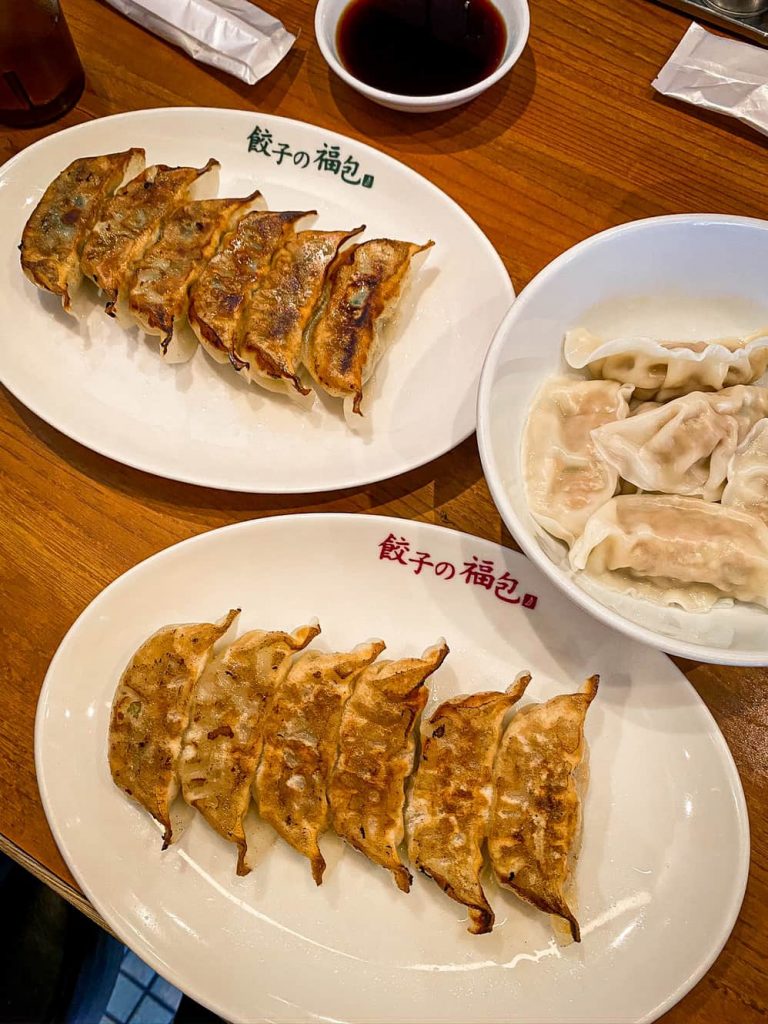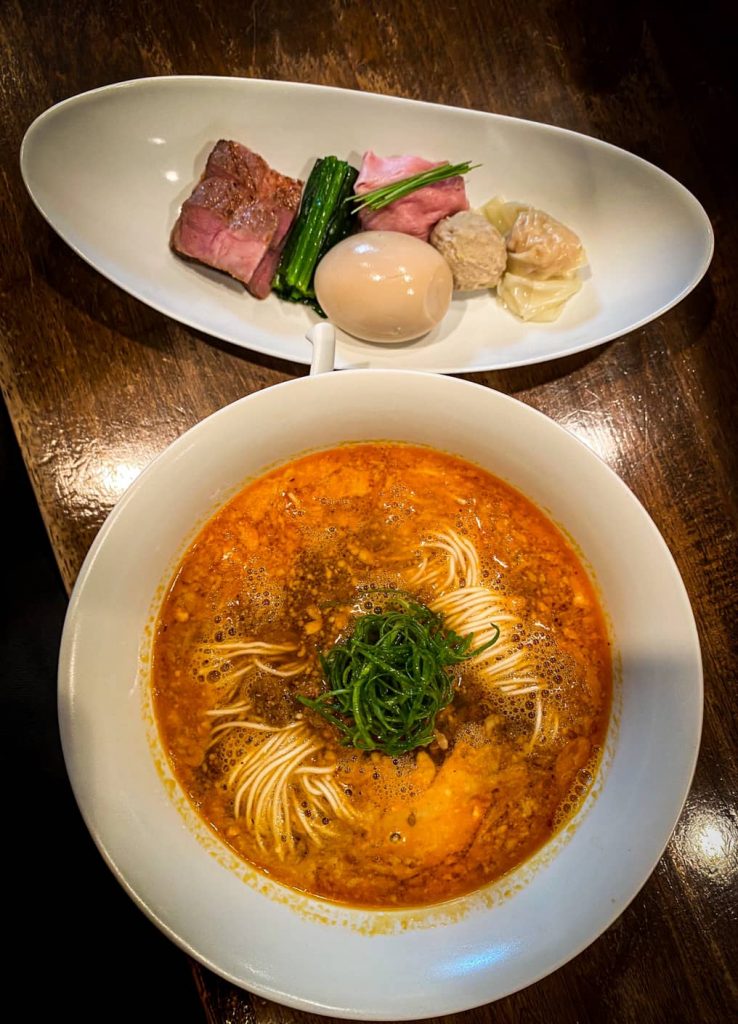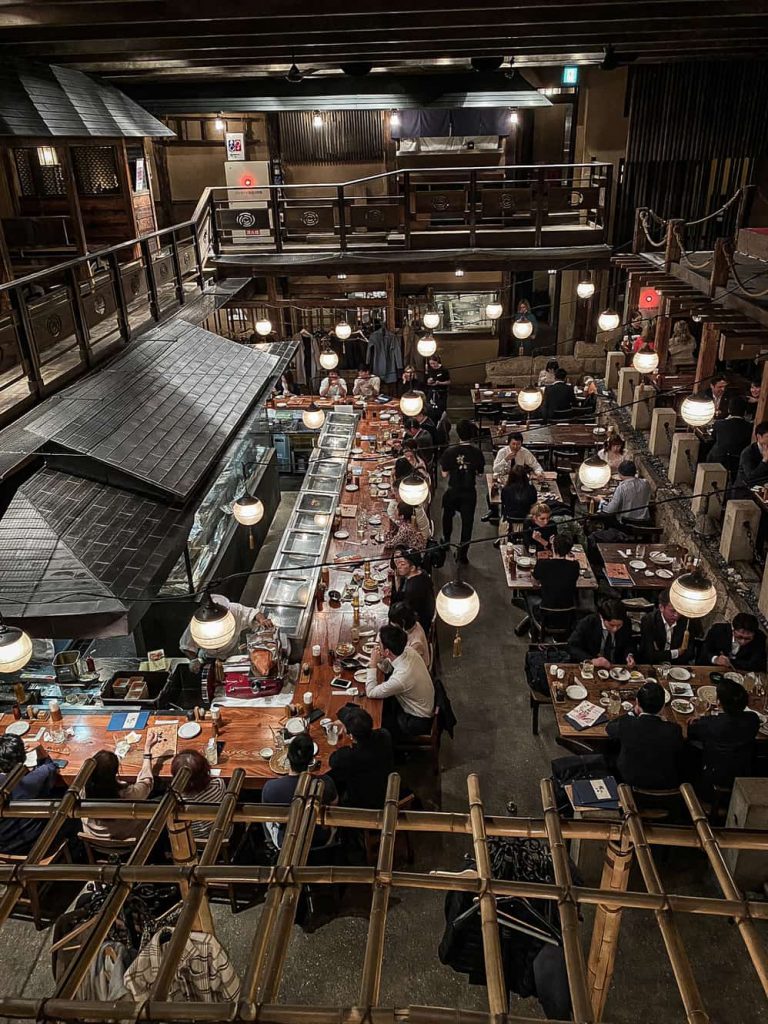There are endless reasons why you should visit Tokyo, but the one that led me there was the food. However, when I started to run a search on which restaurants to choose for my 6-day stay, that caused me a bit of an anxiety attack.
Yes, because Tokyo boasts more than 160,000 restaurants and 226 of them are Michelin starred, the most of any other city in the world (Paris is the second one with its 119 starred restaurants).
Another daunting task was to have as many food experiences as possible, between sushi, ramen, yakitori, gyoza, tonkatsu, and so on.
In only 6 days I did my best to tick all the boxes and this article is the result of my experience in the city where eating is the main activity and restaurants are the main attractions.

Gyozas are originally from China but have become very popular in Japan, mostly served in ramen shops or izakaya (Japanese pubs), and of course in gyoza restaurants. Gyoza No Fukuho is one of them and for sure among the best. The dumplings here are made in a classic way, filled with ground pork and vegetables, and accompanied by the standard soy, vinegar, and chili oil dipping sauce.
From their simple menu, you can choose to have your 6 gyoza plate, pan-fried or boiled, with or without garlic, for only ¥290. I highly recommend you try the pan-fried one, deliciously soft and juicy with a thin crispy bottom.
Ginza Kyubey opened in 1935 and is well known for being one of the best sushi restaurants in the world. It’s also famous for being the first restaurant to introduce uni (sea urchin) and ikura (salmon roe) in sushi, creating the Gunkan-Maki.
The venue is distributed over several floors with bar counters where you’ll be hypnotised by the harmonious movements and the precision of the sushi chefs, and surrounded by the typical zen style interior design.
Here, the standards and the freshness of the fish are impeccable, so don’t expect to spend little. However, you can enjoy its sushi courses at a more affordable price for lunch.
Most of the dishes at Kyubey are nigiri sets but you can tell the chef your preferences.
As a bonus, it’s also relatively English and foreigner-friendly. Booking in advance is a must.

Would you believe it if I told you that in Tokyo you can eat in a Michelin starred restaurant and spend around 10$ only? Yes, at Nakiryu this is possible. You’ll experience one of the most delicious bowls of ramen on the planet. The only flaw is that queues are inevitable, and even if orders are limited to one bowl per person, your wait can vary from 30 minutes to 2 hours as this ramen bar has only 10 seats and they don’t take reservations.
While you wait, they will bring you the menu and when your turn finally comes, you can order through a vending machine located just inside the venue, which accepts cash only.
There are three different ramen styles at Nakiryu: Tantanmen, made from sesame seeds and spicy red peppers; Shoyu, made from soy sauce; Shio, which is salt-based.
I opted for the Tantanmen (¥900), which is the one that draws the crowds. The broth was spicy at the right point, with a rich nuttiness from the sesame seeds, while the noodles were perfectly handmade and firm. If you feel hungry, you can have an extra noodle refill. I also upgraded my bowl with a deluxe topping for ¥500, including 1 thin sliced pork portion, 2 grilled pork portions, 1 duck meatball, 1 soy-dipped egg, 1 shrimp & pork wonton, and vegetables.
If you ask where to eat a good Tonkatsu to a Japanese they will most probably direct you to Maisen.
The main store first opened in 1965 and is located near Omotesando Station, inside an old converted retro style bathhouse.
Maisen enjoys a big reputation for its very high-quality Tonkatsu, which is a Japanese-style pork cutlet, breaded, and deep-fried to perfection.
The menu offers different kinds of cuts and breed of pigs, from the most exclusive Kurotuba (black pork), considered so tender that you could cut it with your chopsticks, to the popular loin cut with its right amount of fat that will melt in your mouth.
All the cutlets are served with a bowl of rice, cabbage salad, pickles, and miso soup.
If the line is too long and you don’t feel like waiting, you can grab a takeaway sandwich from the kiosk next to the restaurant.
I’m sure you have already heard of conveyor belt sushi, but Uobei is different – here, you place your order using the touch screen at your seat, and literally 1 minute later, a little shuttle will storm out of the kitchen at top speed and place your sushi right in front of you. This is a unique and fun way to experience proper Japanese technology and order multiple items without bothering a waiter or waitress every time.
The sushi here is fresh and brilliantly cheap, dishes start from only ¥100, less than $1.
This innovative restaurant is located in the busy neighbourhood of Shibuya. You might find a queue outside but don’t despair, it moves fast.
As a ramen addict, I went visiting many ramen bars in Tokyo and I was impressed by Kyushu Jangara.
I left this tiny hole totally satisfied after testing their specialty, Tonkotsu ramen, a thick broth based on pork bones boiled for several hours. The bowl of ramen is topped with sesame, leeks, bamboo shoots, mushrooms, a half soy-dipped egg, and of course pork belly and fatty braised pork cut into rough pieces.
Once you take your first slurp, the noodles will blow your mind and you won’t be able to stop eating. If pork is not your thing, they also have vegan ramen.
There are 5 Kyushu Jangara around the city and I’m pretty sure the most fascinating and colorful is the one in the manga district of Akihabara, a perfect lunch spot for when you visit this area.

If the interior of this restaurant reminds you of something, that’s probably because you’ve already seen this venue in a movie. This site was used to film the famous fighting scene of the movie Kill Bill.
For this reason, it is a very popular and touristy spot, but if you are a Quentin Tarantino fan you can’t miss a visit here.
Gonpachi is an izakaya, a casual place where colleagues and groups of friends meet up after work for drinks and food, a sort of Japanese pub, in a nutshell.
The food at Gonpachi, like most of izakayas, include chicken karaage (Japanese-style fried chicken), yakitori (chicken skewers), edamame, grilled fish, sashimi, tempura, and much more.
However, this is more expensive than a regular izakaya, and it’s recommended to make a reservation.
Finding this place is an experience itself. Once you’ve found it though, don’t be intimidated by the shady blind alley as I guarantee you’ll have a memorable experience inside.
Michishirube is the typical kind of restaurant that I was expecting to find during my stay in Japan – tiny, cramped, noisy, smoky, and overcrowded.
Here they serve only yakitori, probably the most popular Japanese comfort food, which consists of different parts of the chicken, from neck to tail, grilled on a bamboo skewer. It’s affordable and it goes well with an ice-cold beer.
Bear in mind though, this is a well know spot mainly frequented by locals, so better go there 30 minutes before the doors open, at 7 pm. Also, they don’t have an English translation of the menu but the friendly staff will help you out.
In this fun atmosphere, you can order popular skewers such as momo (chicken thigh), tsukune (minced chicken in sweet sauce), tebasaki (chicken wings), or go for something more challenging like nankotsu (chicken cartilage), sunagimo (chicken gizzard), kawa (neck skin) or bonjiri (chicken tail).
Tongue, throat, rectum, uterus, spleen, and gullet are only a few of the pork skewers that you can find at Nihon Saisei Sakaba. It’s called Horumonyaki, a kind of Japanese cuisine made from beef or pork offal. The menu might shock you, but everything is grilled to perfection and tastes delicious.
Do you dare to try? Get a spot at the counter and start to order some skewers, there are some less adventurous cuts like bacon and neck. Another peculiarity is that this is a stand-up restaurant but, to your advantage, skewers are as cheap as ¥150 for most of them.
For kawaii lovers – Hatcoffee Probably boasts the most impressive and artistic Cappuccino throughout the city. This little café was recently opened by Kohei Matsuno, a very talented artist known for his latte art skills. The biggest novelty is that he can recreate anything you want on your cappuccino or latte, just by being shown a picture of your beloved pet, manga, or even a picture of you. Then you can choose between making your latte art 2D or 3D and watch him transforming it into a masterpiece right in front of your eyes. The drinks are not just good-looking though, they are also delicious. Pair them with the homemade muffins and cookies to top it off.
Conclusion…
I really hope you will enjoy this little list of my favourite restaurants in Tokyo and I recommend following my steps into the memorable culinary experience of Japanese food.
What’s your favourite restaurant in Tokyo? Let me know in the comments!




















Great photos and places
Thank you very much.